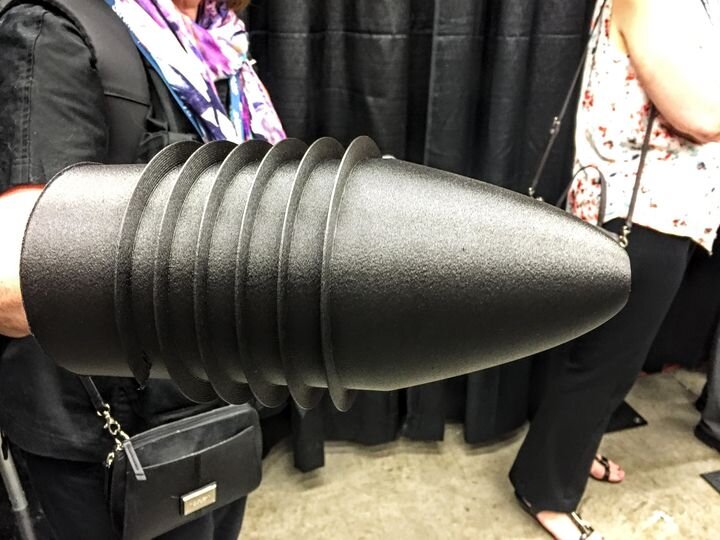![A 3D print made of composite material [Source: Fabbaloo]](https://fabbaloo.com/wp-content/uploads/2020/05/image-asset_img_5eb050b4367e4.jpg)
Flexible additive manufacturing processes, like those offered by 3D printers, have already radically changed how businesses approach manufacturing. Quick turnaround times allow for rapid prototyping, made-to-order parts and small production batches at economical costs.
Now, new composite materials may disrupt manufacturing again by expanding what you can do with a standard 3D-printer.
There’s a lot to learn about composite materials — what they are, how you can use them and the ways they may be disrupting 3D printing.
What Are Composite Materials?
Composites are any 3D-printing material made out of two or more substances where both remain distinct even after printing. These composites are different from alloys in that they combine two things to create a mixture with unique properties. In contrast, alloys combine two different types of metal in a more-or-less homogeneous combination. Often, it’s possible to distinguish the different materials that constitute the composite in a finished object or part.
These composites are generally designed to provide an alternative to the two most commonly used 3D printing materials: plastic and metal. Plastic is lightweight and affordable, but isn’t particularly resilient. It can break down or fail in extreme conditions — like high heat, sudden shock or pressure. Metal, in general, is more robust, but is much heavier and require specialized 3D printers — which cost around $5,000. By comparison, some of the cheapest plastic-printing 3D printers can cost less than $200.
Printable metal itself is expensive enough that it can be out of reach for many small businesses and individuals, even if they have the right equipment. Metal can also be nonviable in cases where project margins are tight and there’s little extra money for expensive printing materials.
Typically, composite materials are made using a combination of a synthetic, fibrous material — like carbon fiber, fiberglass or kevlar — and traditional thermoplastic, which is one of the most common 3D printing materials. With the right equipment, however, you can print a composite made out of plastic and a huge variety of fibrous materials, including aramid, glass fiber, copper, nichrome fiber and even fiber optics.
These 3D-printing carbon materials work similarly to other composites used outside of 3D printing. Two or more elements are combined or machined together to provide an object that’s more suitable than either of the originals, while usually beating the cost of the most suitable noncomposite.
How Can Composites Be Used?
Each composite material has unique strengths that can make it effective for different applications.
Carbon fiber has a very high strength-to-weight ratio, making it a good choice for manufacturing parts that are both lightweight and strong. 3D printing uses two kinds of carbon fiber — chopped fibers made up of short, chopped strands, and continuous fibers, which are much longer, continuous strands. Both are mixed into traditional thermoplastics to create what is called a filled or reinforced thermoplastic material.
In either method, adding in fiber improves the strength of the thermoplastic without significantly increasing its weight. Both types of carbon fiber will also provide some unique additional benefits. Chopped fiber-reinforced thermoplastics can often be printed without specialized continuous fiber printing equipment that allows 3D printers to mix strands of fibrous material with plastic. Plastic reinforced with chopped fiber will be stronger, stiffer and more stable than a similar nonreinforced thermoplastic.
Continuous fiber-reinforced plastic is harder to print, but even stronger than plastic reinforced with chopped fiber. This results in a plastic material with strength and resilience that is almost comparable to metal.
Whenever a manufacturer needs strength comparable to metal at a fraction of the weight, carbon fiber can be used.
Other composites, like kevlar, can be incorporated into thermoplastics using similar methods. With kevlar-reinforced plastic, the composite will provide much greater shock resistance — good for any part that needs to endure high-impact conditions or sudden strikes.
How Composites May Change 3D Printing
These composites have become very popular over the past few years, mostly due to how they can reduce manufacturing time and costs while also expanding the range manufacturers have when it comes to 3D printing.
These new composites may reduce the cost of printing strong parts designed to withstand harsh or atypical operating conditions and expanding the ability to almost anyone who has a 3D-printer. This may make it more realistic for smaller businesses and individuals to use 3D printing. They can make a part or object that is highly resilient — strong under pressure, resistant to shocks and blows, and able to stand up to high levels of heat.
Continuous fiber printing can also make some completely new applications of 3D-printing tech possible — like a rudder printed with fiber optics that can sense and report changes in temperature, pressure, acceleration and electrical conductivity. Composite material printing could enable quick manufacturing of advanced parts that can intelligently detect and report subtle environmental changes.
Composites Are Changing 3D Printing
Manufacturing has been disrupted over the past few years by the rise of flexible and cost-effective 3D-printing tech. Now, new advancements in composite materials are poised to disrupt the industry again.
Composites, especially carbon fiber, can provide significant improvements in strength and stiffness to typically weak thermoplastics — making it possible for just about anybody to print highly resilient parts without needing a specialized metal printer. Other advanced composites, like optic fiber-filled thermoplastics, could provide the opportunity for manufacturers to develop even more innovative applications of the tech.

